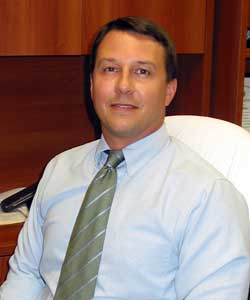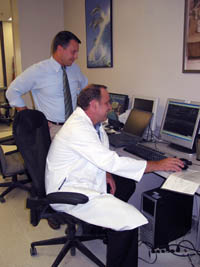 |
 |

|
|
Joseph Miller, Prosthetist, Chemical Research Prosthetist, United States Armed Forces Amputee Patient Care Program, Walter Reed Army Medical Center, Washington, D.C.
|
1. I chose this career because...
2. My typical workday involves...
3. What I like best/least about my work...
4. My career goals are...
5. When I'm not working, I like to...
|
|
1. I chose this career because...
|
Back to Top

|

|
|
Joseph Miller consults with a colleague to organize the day’s work schedule.
|
I chose to become a prosthetist because of an unforgettable event, a family tradition, and training opportunities. As a teen, I attended a charitable function for disabled children sponsored by The Benevolent & Protective Order of Elks of the USA (http://www.elks.org/) with my father. There, for the first time, I saw kids wearing braces. I never forgot that occasion.
Joining the Army: A Family Tradition
After high school, I couldn’t decide between a career in architecture or medicine. In keeping with our family tradition, I joined the Army. During my four-year tour of duty, I was trained as an orthotist. After three years, I received an early out to finish my undergraduate degree. I applied and was accepted into an orthotics/prosthetics program. The program only accepted 10 students every two years. My Army training in orthotics was instrumental to my acceptance. While working on my bachelor’s degree, I remained in the Individual Ready Reserve.
Working with Continuing Education
I completed my residency in prosthetics at the Los Angeles Shriners Hospital (http://www.shrinershq.org/shc/losangeles/index.html) in California and then went into private practice. I eventually managed a business in prosthetics. At the time, I wanted to continue my education, but could not decide if I wanted a Master of Business Administration (MBA) degree or a master’s degree in Science. I finally decided to go to Virginia Polytechnic Institute and State University (http://www.vt.edu/) in Virginia for a Master’s in Health Promotion to learn how to promote my field of prosthetics.
A Prosthetist and A Patient-General Update a Department
I had the opportunity to come to Walter Reed Army Medical Center (WRAMC, http://www.wramc.amedd.army.mil/) as a consultant. I was promoted to a Second Lieutenant in the Medical Services Corp of the Reserves and began my career in the Amputee Care Program. After the invasion of Iraq, my task was to bring the orthotics/prosthetics department up-to-date to better rehabilitate the in-coming wounded soldiers at WRAMC. The medical command wanted to see change and improvement.
During this time, an army General became my patient. As I assisted him with a prosthesis for an injury received during Vietnam, we had a conversation about the Prosthetic and Orthotic Department. I showed him the computer driven production of a model of an amputee’s leg. He was amazed and wanted to see more advanced technology at Walter Reed. Because of the General’s influence, Walter Reed received a Department of Defense grant to remodel the department and to engage in research.
College Education
- Bachelor of Science, Health Science: Orthotics & Prosthetics, California State University (http://www.csudh.edu/), Dominguez Hills, Carson, California
- Master of Science, Health Promotion, Virginia Polytechnic Institute and State University (http://www.vt.edu/), Blacksburg, Virginia
- Doctor of Philosophy (candidate), Health Administration, Touro University International, Online University
Certification
- Certificate, US Army Orthotics, US Army Academy of Health Sciences, Fort Sam Houston, San Antonio, TX
|
|
2. My typical workday involves...
|
Back to Top

|

|
|
Joseph Miller reviews work progress with a technician who is finishing a plaster model of a patient’s limb.
|
My typical workday involves research, consulting and clinical practice.
Research
Since we use computer driven means to duplicate a patient’s stump, I have a digital record of all patient care. This allows me to participate in research projects that use the record of decisions made during production of a prosthesis, the record of changes in techniques, and the introduction of new technology. Much of my research is supported by the Defense Advanced Research Projects Agency (DARPA, http://www.darpa.mil/). This agency has successfully funded research that has resulted in advanced materials used in medicine, the Internet, and the Global Positioning System (or GPS, a tracking and navigation device). Currently, DARPA is supporting research in a new technology called Brain Machine Interfacing, which will result in more useful, versatile and life-like prosthetics.
Consulting
I also collaborate and consult with various organizations to promote, advance and develop criteria and standards for prosthetics and prosthetists. As a member of various boards, I am in a position to exchange information, promote excellence in my field and shepherd the development of educational standards.
Clinical Practice
I am also involved in the daily management of patient care. I have a spreadsheet of all current patients and the progress of their prosthesis development as directed by a team of certified prosthetists. When necessary, I become directly involved in a patient’s care and will make final decisions on their care protocol.
|
|
|
 |